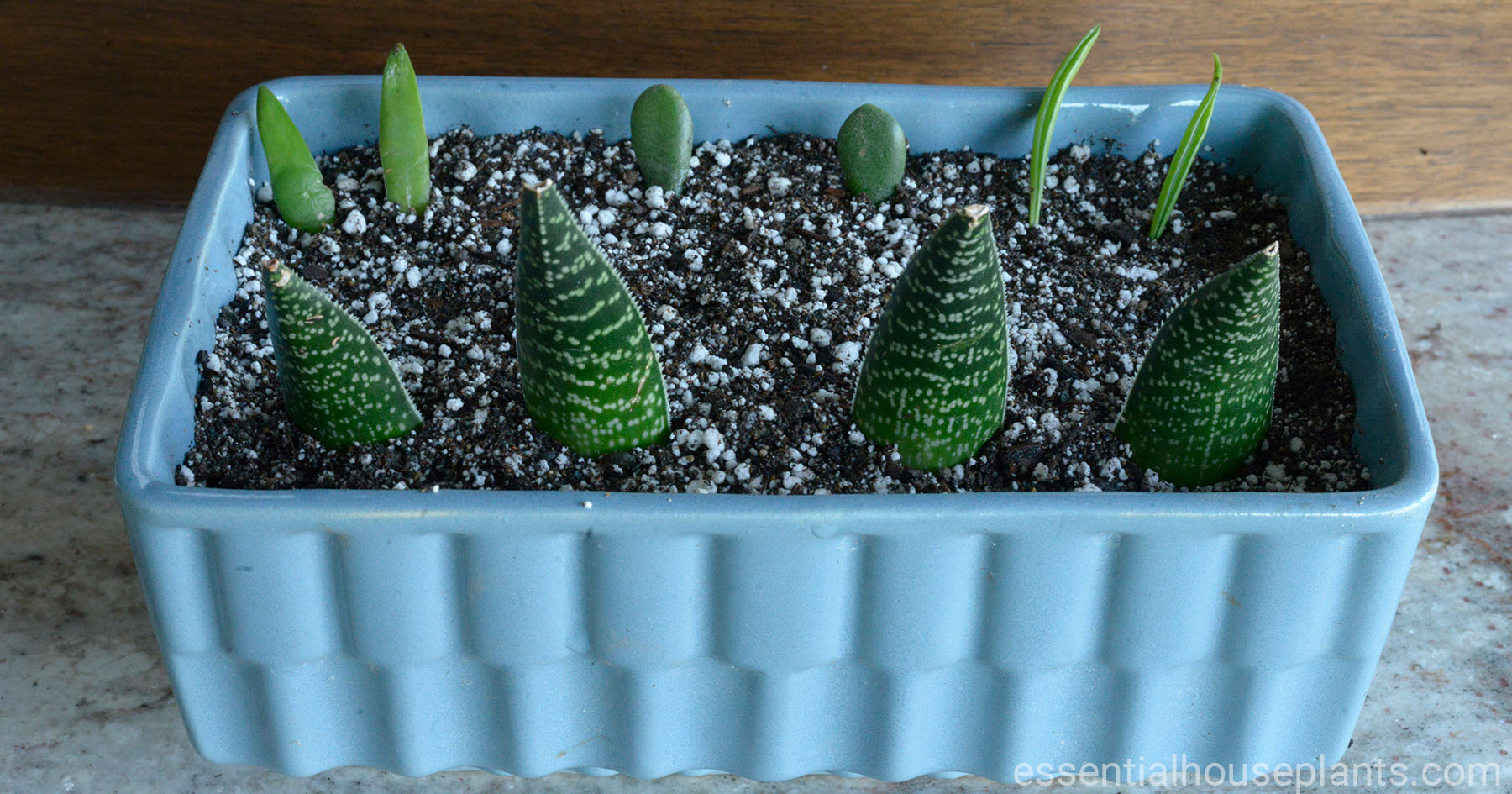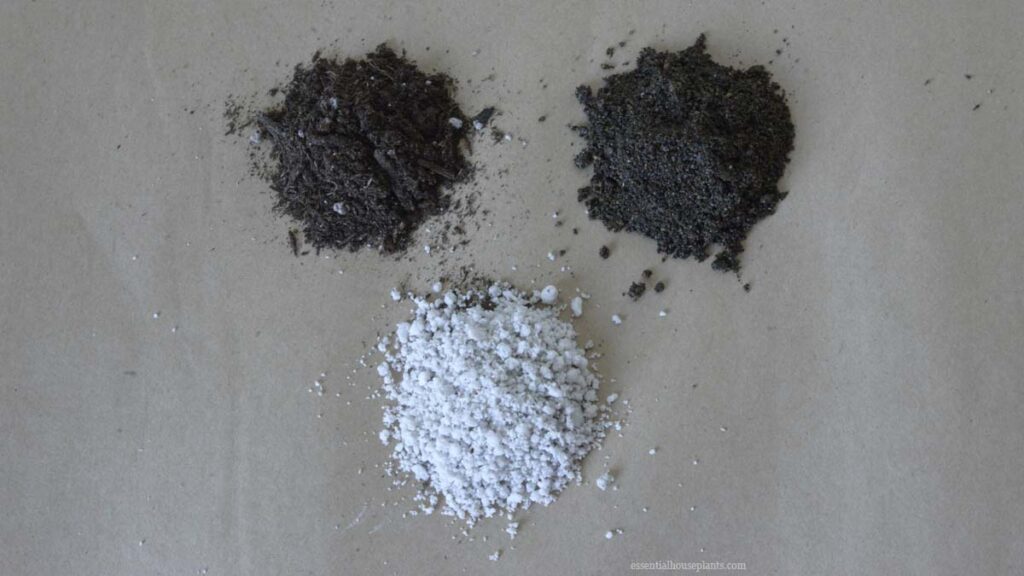Welcome to the fascinating world of succulent propagation, a journey that transforms you from a casual plant lover into a green-thumbed wizard!
If you’ve ever admired the resilience and beauty of succulents and wondered how to multiply your beloved collection, you’re in the right place. Many enthusiasts face challenges like understanding the right techniques, dealing with unsuccessful attempts, or simply not knowing where to start.
As a seasoned gardener with years of experience in nurturing these resilient plants, I’m here to guide you through the simple yet rewarding process of succulent propagation.
This guide is tailored for plant enthusiasts of all levels, whether you’re a beginner looking for a new hobby or an experienced gardener seeking to expand your collection. I’ll share practical tips, proven methods, and personal insights to help you succeed.
Remember, like many of you, I too once faced the daunting task of propagating my first succulent. Now, I’m excited to pass on the knowledge and joy that comes with watching a tiny leaf or stem transform into a thriving plant.
Let’s embark on this green journey together and unlock the secrets of propagating succulents!
- Propagation Methods: Succulents can be propagated using offsets, leaf cuttings, stem cuttings, or seeds, each with different levels of ease and growth times.
- Preparation: Water the succulent well a few days before propagation and sterilize all equipment to ensure healthy growth and prevent disease.
- Harvesting: Gently twist and remove offsets or leaf cuttings from the mother plant. For stem cuttings, use healthy branches and expose the node for roots.
- Curing: Dry the harvested parts in open air for several days to form a protective callus over the cut areas.
- Planting and Care: Plant cuttings in well-draining potting mix, keep in indirect sunlight, and water minimally to encourage root growth.
The Benefits of Propagating Succulents
Home propagation is the cheapest way to build an abundant collection of succulents. With a little effort and patience, you can turn one mature plant into several, or even dozens, of baby plants.
In addition to propagating your own plants, you can ask your friends and acquaintances for cuttings. Most plant lovers are happy to share, and will help you put together a diverse collection.
Note: Propagation can also be good for your plant. By removing and propagating offsets, your succulents have plenty of room to grow.
If you live in a cooler growing zone, where your plants tend to get inadequate light, propagating can help. Light-starved succulents grow leggy and etiolated. Also, a succulent’s older leaves often become unattractively dry and damaged.
Propagation techniques allow you to remove the excess stem or damaged leaves and restart the plant in a healthier, more attractive form.
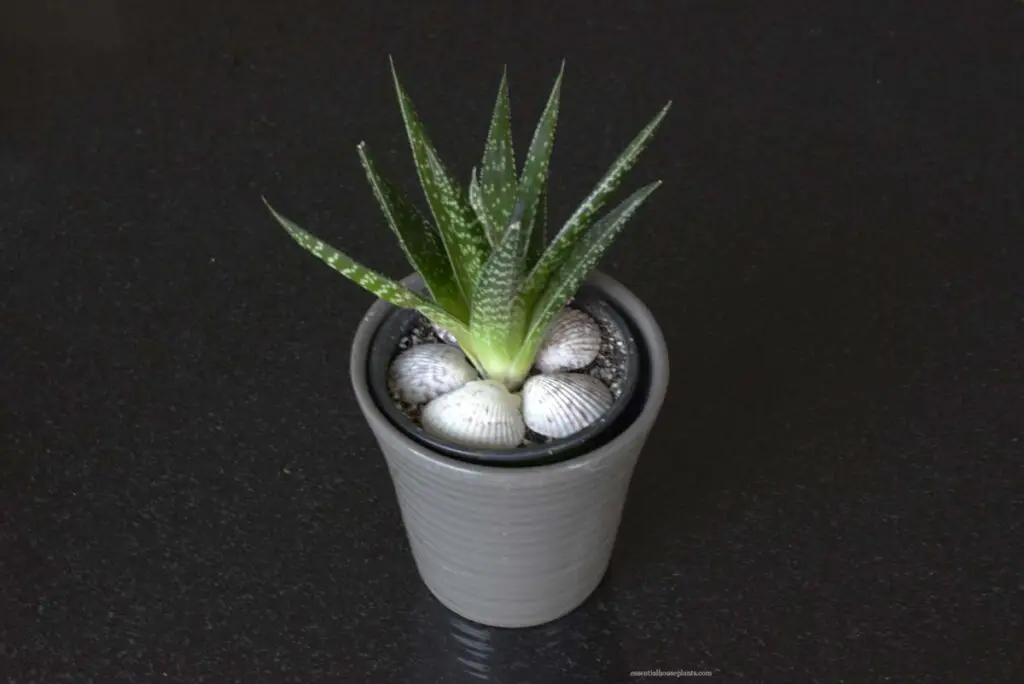
Methods of Propagation
| Propagation Methods | Pros | Cons |
Using Offsets | Easiest, benefits host plant, most likely cutting to thrive, fastest time to maturity | Separating offsets can damage host plant, not an option until host plant and forms offsets |
| With Leaf cuttings | Easy, propagate many seedlings from one host, a use for naturally dropped leaves | Changes appearance of host plant, success rate is rarely 100%, slowest cutting to mature |
| With Stem cuttings | Easy, relatively fast, quite reliable, good solution for leggy plants or broken branches | Changes structure of host plant, slower to produce a mature plant than an offset |
| Planting Seeds | Best way to create a large number of new plants | Labor intensive, takes longer than other methods, requires purchasing seeds unless you have a very mature plant |
Succulent Propagation Mediums
| Propagation Mediums | Pros | Cons |
| Dry propagation (curing) | Highest success rates, avoids rot and disease, easy | Requires an extra step |
| Soil propagation (no curing) | Good success rates, easiest | More potential for rot and disease to reduce success rate |
| Water propagation | Allows you to visualize the roots growing | Labor intensive, higher failure rate |
How to Propagate Using Offsets
Our favorite propagation technique is to use offsets. Also known as “chicks” or “pups,” offsets are baby plants that grow around the base of many succulents on lateral shoots. Most succulents grow offsets, but often (as in the case of Echeveria) not until the plant is mature. Some plants that aren’t succulents like the spider plant also produce offsets.
Sometimes the lateral shoots run underground, but you can generate offsets above the soil line if you behead a succulent (see the section on stem cuttings, below).
1. Preparing to Harvest Offsets
Before you begin propagation, you want to set your plant up for success.
- Water your succulent several days ahead, and let it drain thoroughly. This will allow the plant to soak up and store lots of water, providing essential support to the propagated offsets until they grow roots.
- On the day of propagation, don’t neglect to sterilize your equipment before you begin; sterilizing helps avoid the spread of plant diseases. If you are propagating from more than one, make sure you wash your knife and your hands before working with each new mother plant.
- Designate a space for your new succulents to cure. This area should be out of direct sunlight, warm, and dry. You’ll also want to buy or mix a batch of appropriate potting soil (recipe below).
2. Harvesting Offsets
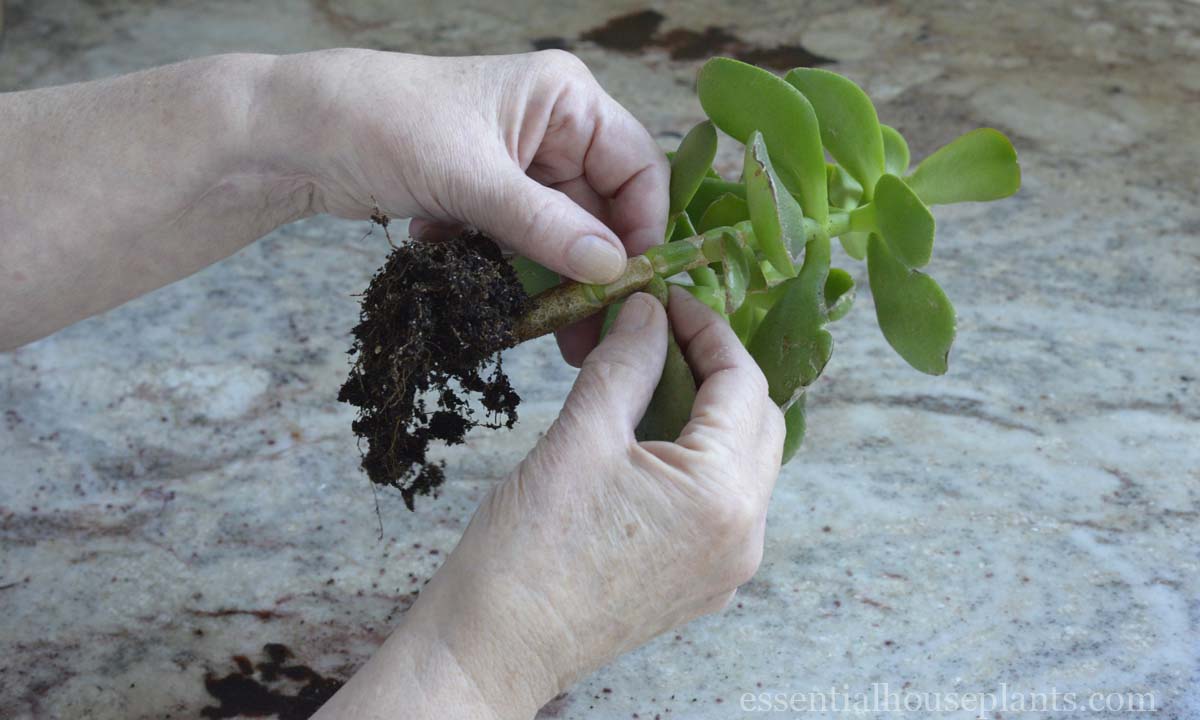
Your goal in harvesting an offset is to remove it entirely (with any attached roots) while avoiding any damage to the mother plant.
- To begin, you need to identify the point at which the mother and pup are attached. If you find it hard to access the area between the offset and the mother plant with your fingers, remove the plant from the pot. You can also use this as an opportunity to repot the mother plant and freshen up the soil.
- Firmly grasp the mother plant in one hand and the offset in the other, getting your fingertips as close to the attachment point as possible. This is important to ensure you remove the entire leaf and don’t damage the stem. Once you have a good grip, remove the offset with a firm but gentle twist.
- If the attachment point is particularly strong and you can’t use the twist-off method without damaging the mother plant or offsets, you can use a knife. Press a sharp, sterile knife through the attachment point between the mother plant and pup. Then, gently pull them apart.
If the offset has roots (this is ideal), gently detach them from the mother plant’s roots. Re-pot the mother in fresh soil. Avoid getting soil or water onto the raw edge of the mother plant. You want it to cure (air dry) uncontaminated.
3. Using Rooting Hormone
You don’t need rooting hormone to propagate a succulent, regardless of what method you choose. While rooting hormone might be useful when propagating using some methods (leaf and stem cuts), offsets really don’t need it, especially if your offset has any roots of its own.
If you want to use rooting hormone, you can dab a bit on the cut portion of the offset before planting it.
4. Curing Offsets
You might think that you should replant an offset harvested for propagation immediately, but that is incorrect. Harvested offsets (as well as leaf and stem cuttings) will have a higher likelihood of success if you allow them to go through a curing process before you replant them. This step is important to avoid bacterial or fungal growth at the cut end.
When we talk about “curing,” don’t think about medical treatment, think about salami. Curing is a process of drying out and toughening the raw opening where you separate the offset (or leaf or stem) from the mother plant.
To cure a harvested offset, leave it lying on a plate or table in the open air for several days. Keep it dry and out of direct sunlight. After a few days, the raw area will have healed over, forming a callus. The cut edge should look drier and duller than when it was first cut, and potentially slightly shriveled.
Note: A callus will form faster in hot dry weather, so if you’re in a cool damp climate you might need to leave it for a week, or even longer for a large cut area.
5. Planting the Offsets
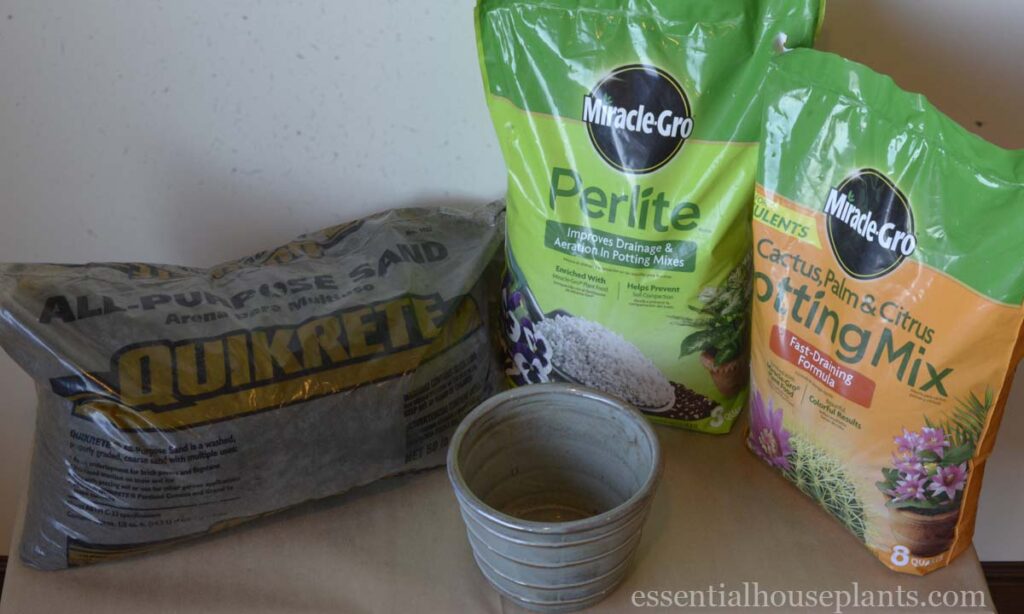
- Plant the callus end of your offset and the attached roots (if there are any) in a pot full of moist, well-draining potting mix. Moisten the soil before potting, rather than watering the newly potted plant.
- Don’t use regular potting soil. You need a potting mix with much better drainage. One of our favorite recipes is one part cactus potting mix, one part coarse sand, and one part perlite. Coarse sand is also sometimes packaged as builder’s sand, sharp sand, or all purpose sand. Basically you want to avoid soft sandbox-style sand. Look for something bigger and more gritty, similar to the texture of very roughly ground black pepper.
Note: Keep in mind that because this mixture has a much lower percentage of organic matter than ordinary potting soil, the plant’s care needs will be different.
First, the potting mix won’t retain a lot of water, which means you’ll need to water more frequently. Second, the potting mix won’t contain as many nutrients, so you’ll need to fertilize. While this sort of potting mix may require a little more effort, to care for your plant, you’ll reap the rewards when your succulent thrives.
- Keep the pot with your newly planted succulent out of direct sunlight for a few days. Bright indirect light is ideal. Once the offset is established you can move it to an area with more sun exposure, but if you’re moving it to a very bright area do so gradually to avoid sunburn.
Note: After the initial planting, let the pot dry out before watering. Be careful not to overwater in the first couple of weeks.
Your baby succulent doesn’t need a lot of water, and limiting the water encourages root growth, but at the same time you don’t want to let the potting mix dry out completely like you would with a mature plant.
How to Propagate Using Leaf Cuttings
Leaf cuttings are another great way to propagate succulents because it allows you to grow more new plants simultaneously —if you wait for offsets or use stem cuttings. Propagated leaves will eventually grow roots, then new leaves, and if you’re patient you’ll be rewarded succulents galore.
1. Preparing the Leaf Cuttings
Prepare for this process the same way as preparing for propagating offsets. Make sure your equipment is clean and sterile. And, water your plant several days in advance and drain it, so that the leaves are full of water when you harvest them. You can also whip up a batch of potting mix if you need it.
2. Harvesting Leaves to Propagate
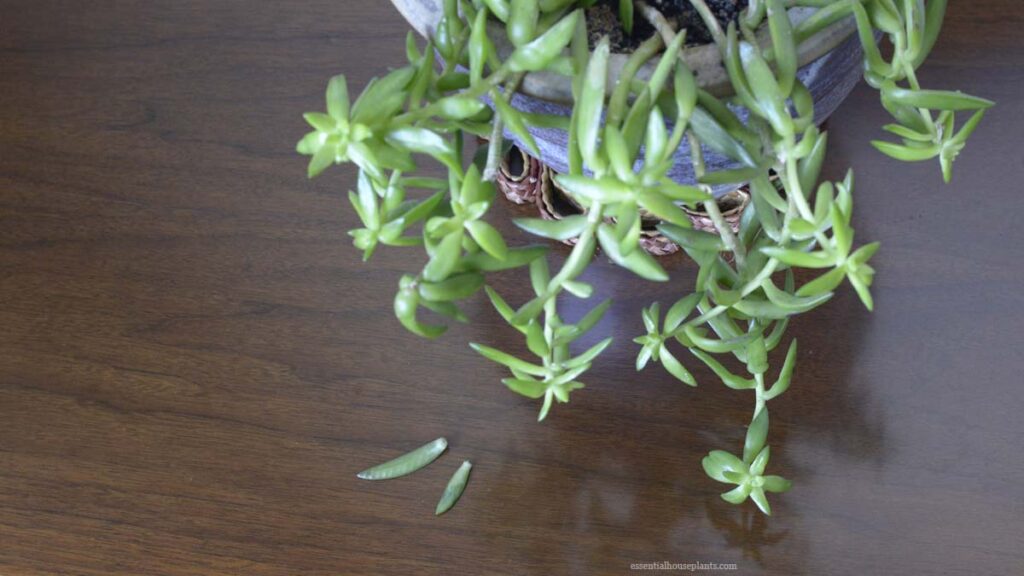
There are two schools of thought about which leaves to use. Some people use leaves that fall off succulents of their own volition. This has the advantage of leaving your main plant intact. However, sometimes these leaves have fallen off because the leaf (or the plant in general) is not healthy, which makes them less than ideal candidates for supporting a baby plant.
The other school of thought is to choose healthy and mature leaves and harvest them from around the base of the plant. This gives you the best chance of success, but it means altering the look of your mother plant, for better or worse. Harvest too many leaves from the base and you may need to propagate a stem cutting to reshape your plant.
To harvest a leaf, you’ll use essentially the same strategy as harvesting an offset:
- Hold the stem with the fingers of one hand, and grip the leaf as close to the stem as possible with your other fingers.
- Twist gently, until the leaf releases. It is important to get as much of the leaf as possible. Leaving a nubbin on the stem reduces the chances the propagation will work because you are leaving behind the meristem tissue.
- If you are harvesting from a large plant with very thick leaves, or if the leaves don’t want to release, you can cut them off with a clean, sterile knife. Cut the leaf off as close to the stem as possible without damaging the stem, so that you keep the meristem tissue attached to the leaf.
3. Using Rooting Hormone
Some gardeners report that rooting hormone can increase propagation success rate because it helps propagated leaves grow good roots faster, and it has antifungal properties. Others recommend using it only for thick stem cuttings of large plants. But, you do not have to use rooting hormones to successfully propagate a succulent.
The reason you don’t really need rooting hormone is that succulents have lots of special cells called meristems that facilitate reproduction, like cloning an animal from stem cells. Also, succulents store nutrients and a lot of water internally. This resource-hoarding provides the life support a plant needs until the meristem cells grow into new roots and leaves.
There is some disagreement among gardeners about when you should apply rooting hormone, if you choose to use it at all. Some recommend using it before curing, while most advise using it after curing. Our preference is to go au natural.
Regardless of when you choose to use it, here’s how you should use a rooting hormone.
- Dip the cut end of the leaf into the rooting hormone. Don’t dip directly into the container – it can contaminate the rest of the product.
- Pour a little out into a disposable cup and dip your plant into that.
- Then, throw out the leftover.
Note: Most proponents of this method use commercially available rooting hormones. However, some gardeners report success using natural alternatives like honey, cinnamon, turmeric, aloe vera, or diluted vinegar.
These are not hormones, like the commercial products, but they do have antiseptic properties (which reduce your chances of losing the offset to fungal or bacterial disease) and according to some gardeners they may encourage root growth.
4. Curing Propagated Leaves
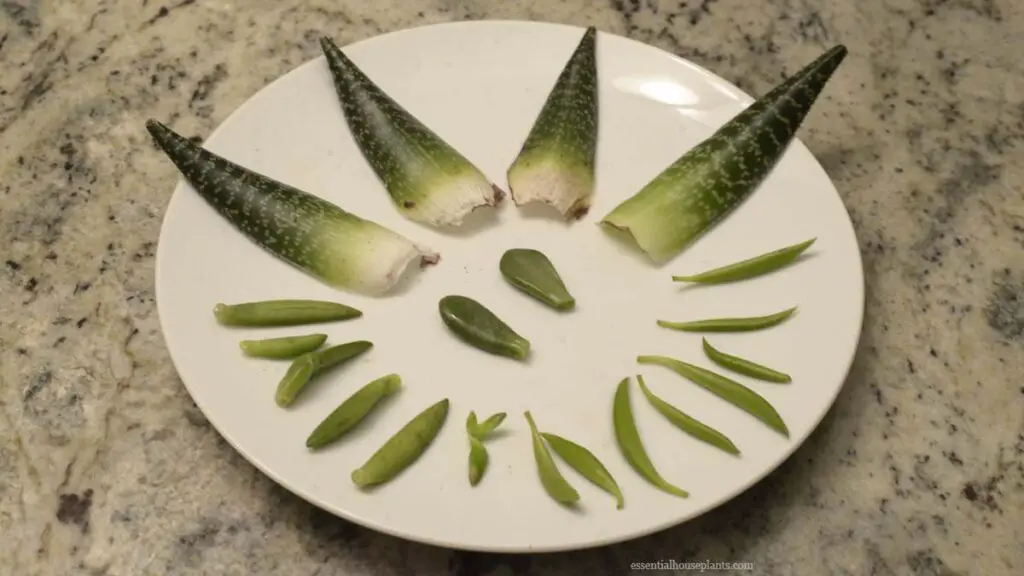
Propagated leaves need a curing period just like offsets and stem cuts. Leave them on a plate, tabletop, empty pot, or on a paper towel until cured, at least three days, but potentially longer (especially in a humid climate). Look for the raw, shiny edge to become dull and dry. During this period make sure to keep the leaves out of direct sunlight.
5. Plant Propagated Leaves
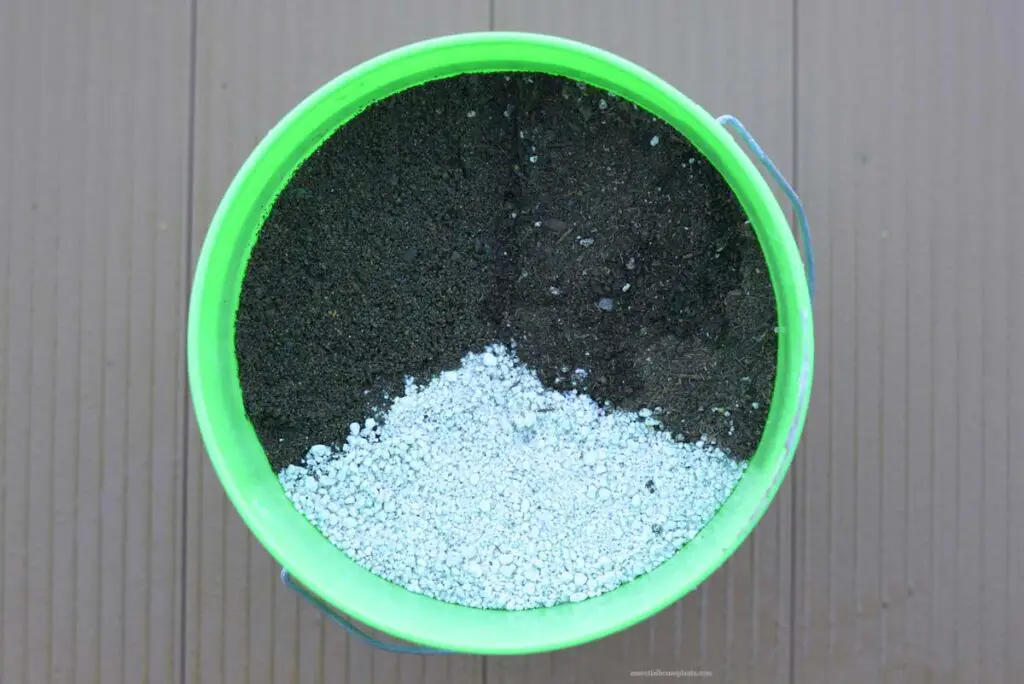
- Make sure your loose, well-draining potting mix is lightly damp before planting. Watering newly planted leaves can disrupt the soil bed, wet leaves (risking rot), and oversaturate the meristem tissue. I like to make my own potting mix with equal parts cactus potting mix, sharp sand, and perlite.
- Planting propagated leaves is as simple as laying them on, or poking the end into, the surface of the potting mix. You want to make sure the stem-end of the leaf (where the meristem tissue is) has good contact with the soil. This is where your roots will emerge.
- It’s best to wait a week or so after planting, and then add just a little water around the plant. Continue this careful watering on an as needed over the next couple of weeks, keeping the soil lightly moist but not too wet.
Note: When watering, avoid wetting the leaf itself.
- At this stage you can move the leaves to an area with brighter indirect sunlight, and eventually direct light. This process of gradually increasing the light protects the vulnerable plants against sunburn.
It may take several weeks for your leaf to grow roots, and even longer for it to grow new leaves. The length of time it takes a leaf cutting to get roots or shoots can vary based on factors such as the season, type of succulent, and growing environment.
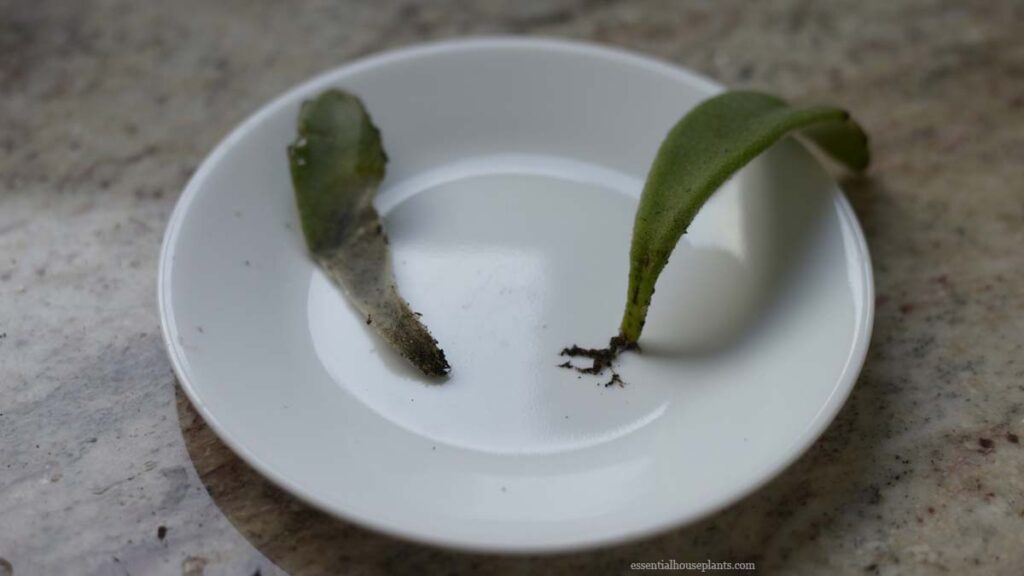
If you propagate in the fall or winter, you may see minimal root growth during the winter dormancy, but be patient. A leaf that looks like it is dying off slowly may still produce new growth in the spring.
You may have to give up on some of your leaf cuttings. Some are destined to fail. If a leaf loses its plump fleshy quality and becomes limp, it isn’t worth keeping. When you propagate using leaves, it’s best to plant extras based on the assumption that some fraction won’t take.
6. Detaching the Host Leaf from the Baby
Eventually your new plant will have a well enough developed root system that it won’t rely on the leaf from the mother plant for water and nutrients. At that point you can remove the original leaf and let the baby succulent grow on its own. A good time to remove it is when the new plant is a half-inch to an inch tall.
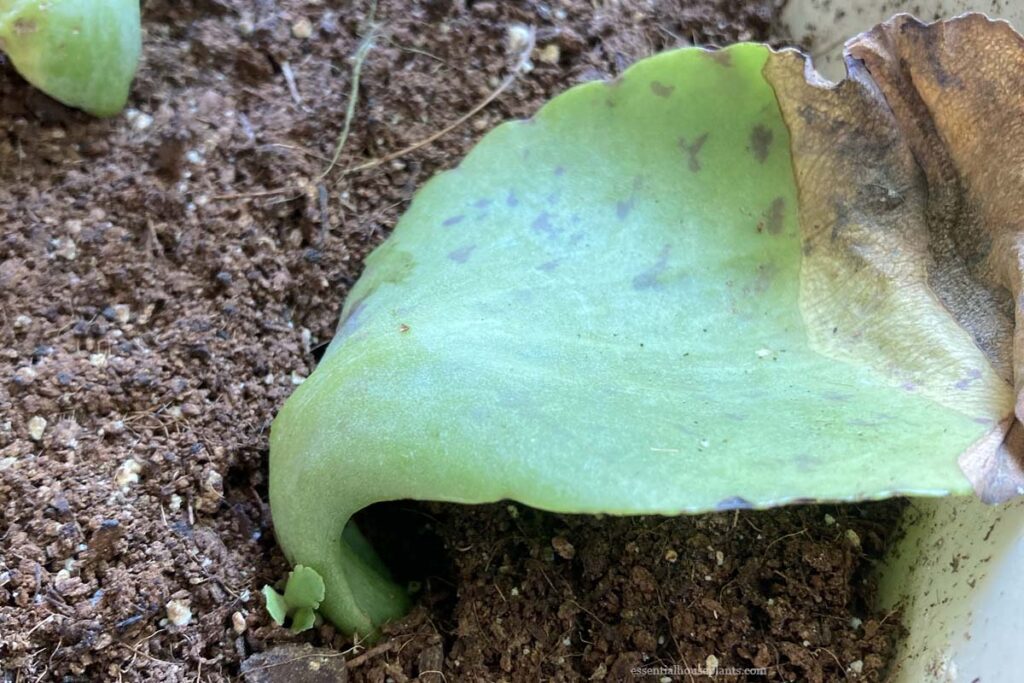
Hold the base of the new plant gently but firmly with the fingers of one hand, to protect it from ripping off from the new roots. Then, with your other hand carefully twist off the old leaf. Alternatively, if it feels firmly attached, you could cut it off with a sharp, sterile knife.
Note: If the old leaf feels very firmly attached, like removing it might damage the new plant, consider leaving it a little longer, until the new plant is sturdier.
After you remove the host leaf, be careful not to get soil or water on the raw area while it cures. After curing, you can gradually transition to watering your baby like a mature plant (drenching it, draining it, and then allowing it to dry out before watering again).
How to Propagate Using Stem Cuttings
Stem cuttings are an easy and effective way to get new plants relatively quickly. It is also a good way to make use of broken branches. What’s more, when you take stem cuttings from a rooted plant, the stump of the plant will often produce several new branches or offsets, which means even more baby succulents down the road.
1. Preparing for Stem Propagation
Several days before stem propagation, you should water your plants well, and drain it thoroughly. This will ensure your cutting is full of water and nutrients to sustain it while it grows roots.
Note: Unlike offsets and leaves, propagating stems requires a cutting implement. You can use a knife, but pruners are ideal. Make sure your blades are sharp; dull pruners will bruise the stem tissue.
You should also sterilize your pruners before propagating. Wipe them with alcohol before you begin, and between propagating different plants, to avoid cross-contamination.
2. Harvesting and Preparing Stems to Propagate
As in the case of leaf propagation, sometimes life chooses and harvests the stem for you.
When I moved my plants cross-country, my panda plant was smashed in transit. This was in the fall, the worst time for propagating, but I gave it a shot anyway. After throwing out the most damaged parts, I was left with a stump (with a couple of small branches), two large detached leaves, and two broken stems.
I propagated all the pieces in the same pot as the stump. Of those pieces, one leaf withered. Four months later, the other leaf is still healthy, with tiny roots and no new leaves. The best part is that the two stem cuttings and stump have ignored the winter dormancy period and are all growing well.
Note: If your plant isn’t an accidental amputee, you’ll have to choose which branches to propagate. You can definitely use healthy, intact branches.
However, another common time for stem propagation is when your succulent has gotten leggy and you want to cut it down to form a shorter and more compact plant.
Each cutting should be 2-4 inches long, give or take. At the growing tip you need to keep at least one healthy leaf, but preferably a couple of sets of leaves. At the root end, strip off two sets of leaves, revealing the node with meristem tissue that will grow roots. Remove them carefully, so that you don’t pull the meristem tissue out of the stem, leaving a crater.
If you are propagating a section of stem that does not include the tip of the branch, make sure to keep track of which end is the root end. Plants only grow in one direction; if you plant it upside down it will die.
3. Curing And Using Rooting Hormone
Like offsets and leaf cuttings, stem cuttings need a curing process. In fact, large stems require a longer curing period than small leaf cuttings. Cuttings typically dry starting at the edges, with the center drying last. Keep an eye on your stem cuttings to make sure they have nice dry calluses all the way across the cut edge before you plant them.
You can use rooting hormone on your stem cuttings, but it is not necessary. The cutting contains plenty of nutrients and water to sustain the plant as it grows roots. In nature, there is no chemical rooting hormone, and succulents reproduce without any problem. However, feel free to use it if you prefer.
4. Planting the Stem Cuttings
When the cut ends are cured, it is time to plant your stem cuttings.
- Use a well-draining potting mix meant for succulents. You can make your own by combining one part cactus potting mix, one part coarse sand, and one part perlite.The resulting product is light and gritty, and doesn’t hold much water, just what succulents like.
Note: Your potting mix doesn’t need to be bone dry, but at most it should be slightly moist. This is because your succulent doesn’t need water from the soil until it forms roots. Until then, the leaves left on the stem provide plenty of hydration.
- Poke a small hole in the soil and stick in the cured root-end of your stem cutting.
- Put the pot back where you cured the stems, or somewhere with indirect light but no direct sunlight.
- Leave the planted cuttings to dry for a week or two, then begin minimalistic watering. It is good for the plant to be a little thirsty, as this stimulates root growth.
How to Grow Succulents From Seed
You can grow succulents from seed, if you’re determined. This process is much more time consuming than other propagation methods, but if you can’t buy the succulent you want locally, and don’t know anyone with a plant you can propagate, ordering seeds might be a good option.
One thing to be aware of is that cultivars and hybrids may not grow true to seed. In other words, you might get a plant that is similar to the parent plant, or you might get a genetic throwback. That’s why it is important to use a reputable source of reliable seeds.
1. Planting Seeds
You can plant your seeds in a standard seed starting mix or in a succulent potting mix. I like to mix equal parts cactus mix, coarse sand, and perlite.
- Fill your seed starting trays or other small containers with your potting mix.
- Wet the soil to the point of full saturation, either by soaking them from below or watering gently from above.
- After watering, make sure the tray is drained.
- Wash and thoroughly dry your hands to make handling the tiny seeds easier.
- Use one seed per container or per cell in the seed starting tray, to the extent possible.
Note: You do not need to put any potting mix on top of the seeds.
- Cover your container with a clear plastic lid. This will keep the soil moist longer.
- Place the seeds in bright direct sunlight or under a grow light.
- Keep the seeds at a comfortable temperature, 60-80 Fahrenheit.
- Keep the tray watered to ensure it never dries out. This may require daily watering. However, avoid oversaturation, as this can foster mold.
2. Caring For Seedlings
Once the seedlings sprout and have grown an inch or so, remove the plastic lid. If you accidentally ended up with more than one seedling per container, snip off the tops of all but the healthiest seedling with a pair of scissors.
- Continue to keep the seedlings consistently moist. They are so tender at this stage that drying out could easily be fatal.
- Continue to provide bright sunlight and/or a grow light daily.
- As the roots begin to grow, the plant will have a greater capacity to find water as the soil begins to dry out, so you can reduce the frequency of watering a bit. You will eventually transition them to watering using the soak and dry method (saturating, draining, and then allowing the soil to completely dry out between waterings), but not until they are relatively mature.
- Allow your seedlings to grow for as long as possible before transplanting them. Only transplant them when the roots are visible through the drainage holes in the bottom of the container.
- Let them grow around six months before disrupting them. Throughout that time, you will need to keep them well watered.
You will need to be patient and diligent. Seeds may take months to a year or more to grow into a full sized succulent. Seeds are also temperamental, so prepare to try again if your first effort doesn’t result in healthy seedlings.
How to Use Other Propagation Techniques
1. Water Propagation
Some people propagate succulents by placing the leaf or stem cuttings so that the cut end is suspended in or just above a container of water. Some succulents will root this way. If they do, you can watch the roots grow and measure their progress, which is fun, especially for kids.
Note: Water propagation generally has a high failure rate, with rot taking many of your cuttings.
The water propagation method is also labor intensive. Devising a setup to keep the end of the plant touching the water without the rest of it getting wet is a hassle. Plus, frequent water changes can disrupt the newly forming roots.
All in all, we recommend against using water propagation for succulents. However, if you are going to use it, you will have an easier time with stem cuttings than trying to use leaves.
2. Propagation Using Nodes
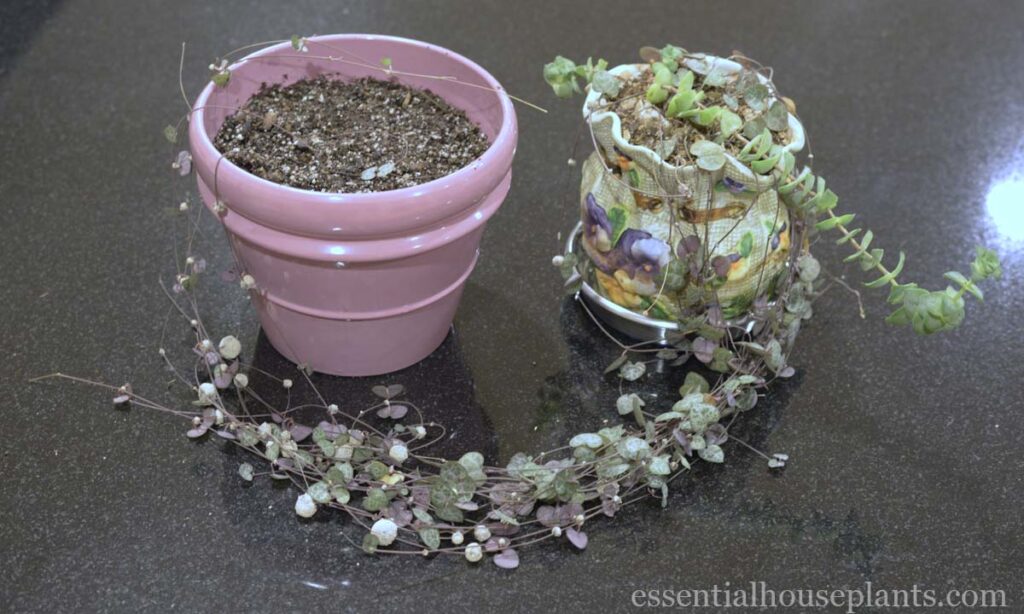
Some succulents offer yet another option for propagation. The string of hearts plant (Ceropegia woodii), for example, is a semi-succulent plant that grows long trailing vines and produces little pink flamingo-shaped flowers.
Eventually, after flowering, the plant forms nodules on its vine, like dried garbanzo beans. These nodules are where the roots will form when the plant is propagated.
Plants with nodules like the string of hearts can be propagated using water or soil, simply submerge or plant one or more of the nodules on your stem cutting. However, the ideal method involves soil-propagating the nodules while the stem is still attached to the mother plant, as in the photo.
Once the nodule has established roots, you can cut the stem and separate the two pots.
Related Article: Cold Hardy Succulents – A Beginners Guide
Problems With Propagation and Their Solutions
It’s Been A Month, Why Don’t I See Growth?
Assuming your propagation technique was correct, one possibility is that you simply did not wait long enough for the new growth. Especially during your plants’ periods of dormancy, you can’t expect to see substantial growth of a new cutting.
In general, if you can wait, it’s best to propagate your succulents in mid-spring. Ideally the plant will be several weeks out of dormancy before you propagate. This will encourage your sprout to grow to a sturdy size before the next winter dormancy.
However, you may just need to be patient. If the cutting still looks reasonably healthy (not dried out or flaccid), continue to care for it, even if you don’t see any sprouts several months later. You may get a new succulent yet.
Why Is My Cutting Brown and Floppy?
Your propagation attempts may fail for any number of reasons.
Perhaps you forgot to water the mother plant in advance, and the cutting lacked the water and nutrients it needed. However, even more likely is too much water.
If you overwater the soil after planting your cutting, it can become waterlogged. Dripping water on the cutting itself can also make it damp and prone to rot, as can failing to cure your cutting. If you removed a leaf but left a nubbin of meristem tissue on the mother plant’s stem, its death may have been predestined before you even planted it.
When it comes to propagation, you can’t win ‘em all. It’s best to accept that, aim for a majority success rate, and plant a few more cuttings than you want new plants. If all of them take, the only consequence is you’ll have extra succulents you can share.
Cuttings to the Chase
In nature, succulents propagate themselves with no assistance from humans. Doing it at home is cheap – it’s so easy a child could do it. In fact, propagation makes a great project for a child who is beginning to show interest in the cycle of life. Regardless of whether you want to pass along the thrill of gardening or simply multiply your succulent collection, give propagation a shot. You have nothing to lose but a few old leaves.

